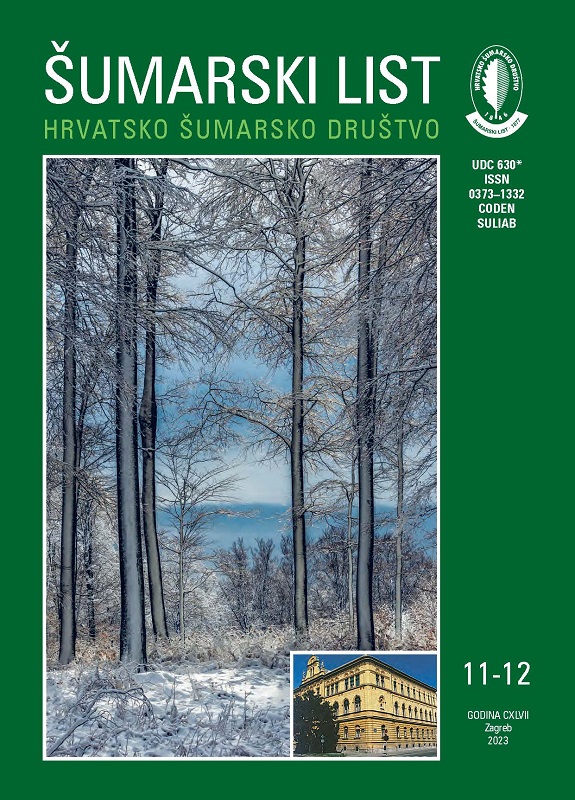
broj: 11-12/2023
pdf (9,99 MB) |
|
||||||||||||||
| RIJEČ UREDNIŠTVA | ||
| Uredništvo | ||
| At the end of 2023 pdf HR EN | 503 | |
| IZVORNI ZNANSTVENI ČLANCI | ||
| Damir Drvodelić, Milan Oršanić, Damir Ugarković, Mario Šango | UDK 630* 232.3 (001) https://doi.org/10.31298/sl.147.11-12.1 | |
| Comparison of vitality and laboratory germination of holm oak acorns (Quercus ilex L.) pdf HR EN | 505 | |
| Abstract Holm oak forests in Croatia are in various stages of degradation, and one of them is maquis, which is a less favorable stage for the germination of holm oak seeds compared to holm oak stumps or stands of high growth form. Holm oak is a xerophytic species of forest trees. From the geological base, it comes from limestone, which is the most common in our Mediterranean area, and dolomite. Begins to flower in the eighth year of life, and the seed harvest begins at the age of 12 to 15 years, and the full harvest is every 4 to 6 years. The holm oak acorn crop is variable, where three abundant acorn crops were recorded in the eight-year period. The full harvest of holm oak depends on climatic conditions, but it also differs significantly between different habitats, especially the geological base and soil type. For laboratory analyses, holm oak acorns were collected in the area of G.J. “Kamenjak” on the island of Rab. The aforementioned G.J. managed by “Hrvatske šume d.o.o.” The seeds were collected in department unit 15a, 16a, 26a and 27a in the period from 01/12/2020 to 10/01/2021. The collection was carried out using the method of shaking acorns from the trees onto mats placed under the canopy and the method of collecting fallen acorns from the ground. Assessment of seed vitality using the tetrazole method and laboratory germination was made according to the ISTA rules for holm oak. The percentage of laboratory germination was determined according to the percentage of normal seedlings that germinated normally after the 35th day of testing. The total vitality of holm oak acorns was high and amounted to 90.25 %, while the rest of 9.75 % consisted of non-vital seeds. Of the vital seeds, the largest percentage (79.50 %) consists of seeds with fully colored embryo and cotyledons. Acorns with cotyledons that has necrosis up to 1/3 on the distal part and are not connected to the embryonic cavity was 10.75 %. In the first seven days, not a single acorn germinated, so the germination energy was 0.00 %. In the first 14 days, laboratory germination was 30.50 %, after the 21st day 76.50 %, after the 28th day 83.75 % and after the 35th day 88.50 %. The difference between the assessment of acorn vitality and total laboratory germination was only 1.75 %. The vitality assessment method is faster and cheaper than the germination test. We get the results of the vitality assessment in 18 hours, while we test the germination after 28 or 35 days. Practical procedures can be based on the results of these studies suggest testing the vitality of the holm oak and not the laboratory germination as recommended by the ISTA rules. The average germination time (MGT) was 19.91 days. There were 74.25 % of regular seedlings and 14.25 % of irregular ones. At the end of the test, 8.50 % of the visually healthy acorns did not germinate, while 3.00 % of the rotten acorns were found. The most common irregularity in the amount of 56.14 % was determined for the category of two joined seedlings, followed by necrosis of primary leaves (12.28 %) and stunted primary root (10.53 %). Other irregularities appear in less than 10,00 % of cases. Key words: island of Rab; tetrazole method; ISTA rules; normal seedlings; abnormal seedlings | ||
| Nera Bakšić, Darko Bakšić | UDK 630* 114 (001) https://doi.org/10.31298/sl.147.11-12.2 | |
| Forest floor fuel loads in holm oak (Quercus ilex L.) and pubescent oak (Quercus pubescens Willd.) forests pdf HR EN | 513 | |
| Mirzeta Memišević Hodžić, Sulejman Sinanović, Dalibor Ballian | UDK 630*164 (001) https://doi.org/10.31298/sl.147.11-12.3 | |
| The relationship of growth characteristics and wood quality on the experimental plot of larch pdf HR EN | 525 | |
| Biljana M. Nikolić, Katarina Mladenović, Ljubinko Rakonjac, Slobodan Milanović, Marija M. Marković, Srdjan Bojović, Nevena Čule | UDK 630*164+272 (001) https://doi.org/10.31298/sl.147.11-12.4 | |
| Influence of crown exposure on the morphological needle traits of nine conifers pdf HR EN | 535 | |
| PRETHODNO PRIOPĆENJE | ||
| Jovana Devetaković, Milutin Đilas, Ivona Kerkez Janković | UDK 630*164 https://doi.org/10.31298/sl.147.11-12.5 | |
| Stocktype impact on survival and growth of one-year old Quercus pubescens seedlings on the edge of Panonnian basin pdf HR EN | 547 | |
| STRUČNI ČLANCI | ||
| Saša Bogdan, Ida Katičić Bogdan, Martina Temunović | UDK 630* 232.3 https://doi.org/10.31298/sl.147.11-12.7 | |
| On the use of foreign forest reproductive material for the regeration of local stands of pedunculate oak from the stand points of a genetics pdf HR EN | 565 | |


